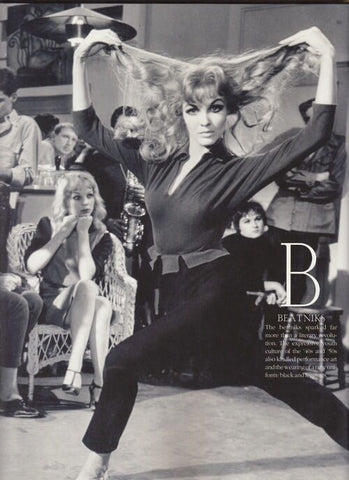The Beat Generation was a literary subculture movement in post-WWII America.

Prolific writers of this movement include Jack Kerouac (who first used the term ‘Beat’ to describe his circle of friends), Allen Ginsberg and William S. Burroughs. The obscenity trials that resulted from their work ultimately liberalized publishing in the United States. Many of these writers met in university in New York and later, in the mid-50s, ended up together in San Francisco as part of the ‘San Francisco Renaissance’.

The term ‘Beatnik’ was coined in 1958 as a derogatory term for the Beat Generation.
Beatnik’s subscribed to an anti-materialistic lifestyle. They expressed themselves through poetry, literature, jazz music and painting. They were eventually absorbed into hippie culture in the 60s.


The stereotypical image of the Beatnik was a minimalist look of dressed down functionality including black clothing, cigarette pants, stirrup slacks, berets, sunglasses, black leotards, striped tops and turtlenecks. Women wore their hair long and loose and men sported goatee beards. What was most important was seeming as though you didn’t care what you looked like. They also wore blue Levi jeans, white T-shirts and workwear jackets- think James Dean in Rebel Without a Cause.

Some of the women writers involved in the movement included Diane di Prima, Joyce Johnson and Hettie Jones. They rebelled against the popular ultra-feminine New Look at the time, instead opting for oversized sweaters, black jeans, pencil skirts and silk shirts.



A popular TV character of a Beatnik at the time was Maynard G. Krebs in ‘The Many Loves of Dobie Gillis’.

Kerouac was critical of the larger culture that had formed, fearing that the spiritual aspect of his message had been lost and that many were using the Beat Generation as an excuse to be senselessly wild. He hated the term ‘Beatnik’.

The Beatles spelled their name with an A as a reference to the movement.
Some 1950s movies with Beat references include D.O.A., Roman Holiday, Funny Face, High School Confidential, Bell Book and Candle, The Beat Generation and a Bucket of Blood.
 Audrey in Funny Face (1957)
Audrey in Funny Face (1957)
Modern films about Beatniks include Howl (2010), On The Road (2012), Kill Your Darlings (2013) and Inside Llewyn Davis (2013).

Lithub.com writes about Beat style:
“This attitude has persisted today in the sartorial choices of students, writers, and artists who dress themselves with a sense of cool indifference—and the functionality of this style also resonates in an era where sustainability is an important element of the conversation in fashion. Now, as then, what we buy and what we wear has a political weight to it. Buying less in the 21st century is often motivated by environmentalism, a continuation of the anti-capitalist legacy of mid-century counterculture.
In the era of fast fashion and tech billionaires, the anti-establishment energy of the Beats feels as urgent today as it did then. Of course, what we buy and what we wear are just two ways to articulate these feelings. Additionally, social conventions around what is acceptable and unacceptable to wear in certain situations has changed a lot since the 1940s. However, the style of the Beat Generation clearly lives on, whether at university campuses and late-night cafes or the Dior runway. The Beat writers might have had conflicted thoughts about becoming fashion icons, but there’s no denying their impact on the wardrobes of young rebels, with and without causes, to this day.”

